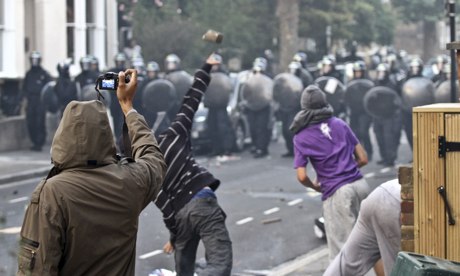
The 2011 riots in English towns and cities catalysed discussions on youth and gang violence and its impact on public overall health. Photograph: John Cantlie/Getty Photos
Gang and youth violence can have a distressing impact on folks, families and our regional communities. The wider social-economic costs, whilst at times much less visible, can be equally as damaging, and the NHS is not immune to this.
The price of violence to the NHS stands at £2.9bn a year (£200m much more than the complete public overall health spending budget that was transferred to nearby authorities this yr).
In 2010-11, a lot more than 189,000 men and women were admitted to A&E simply because of violent incidents some hospitals reported that 9% of all emergency admissions were linked to knife incidents.
The government has sought to respond to this challenge. A single of the central tenets of its response to the 2011 disturbances was to move the situation of gang and youth violence away from becoming solely a issue for criminal justice agencies, and in direction of the wider realm of public wellness. Certainly, in November 2011, the work and pensions’ secretary Iain Duncan Smith stated: “violence is a public health issue. We must start off seeing and treating it as such.”
For the well being system, which has just gone via one of the most substantial reforms in a generation, this generates a true opportunity – particularly in people locations of the nation identified by the Property Workplace as dealing with critical troubles with youth violence.
A current report, Violence prevention, wellness promotion, offers the 1st extensive evaluation of the extent to which new wellness and wellbeing boards are recognising youth and gang violence as a public overall health concern. The report was compiled by Catch22′s Dawes Unit, a social enterprise with branches all through England, and MHP Health’s, a specialist health policy and communications consultancy. The examination focuses on the 33 areas of the country, 60% of which are in London, identified by the government as possessing the most serious difficulties connected with gang and youth violence.
What the study exhibits us is that the bulk (70%) of health and wellbeing boards are taking into consideration gang and youth violence in the arranging of regional well being companies, by including it inside of their joint strategic demands assessment.
Regardless of getting in its infancy, 15% of boards have also confirmed the situation would be a strategic priority for regional well being services in their area, and nearly a fifth have invited a representative from the criminal justice local community to be a sitting board member.
With well being boards in some regions of the nation looking to pioneer this agenda, it is attainable for us to pinpoint examples of excellent practice. The government will require to make sure this excellent practice is shared and designed further, in order to inspire new commissioners and accomplish its ambitions on youth and gang violence.
For us, there are three important areas that require to be addressed. Initial, strengthening the availability and sharing of data on people impacted by gang and youth crime so that care and assistance follows the personal. For example, making certain that hospitals functions a lot more closely with the nearby police force to share information on A&E admissions relevant to knife crime, so that organisations accountable for the care of youthful men and women can target interventions a lot more efficiently.
Second, breaking down institutional silos by involving all relevant agencies, this kind of as the new police and crime commissioners, in the preparing, delivery and funding of services aimed at tackling violence-related incidences.
Third, expanding the evidence base about how a public overall health approach can be employed to react to youth and gang crime, so that cash and assets can be deployed much more effectively.
Although public health does not offer all the answers to this complicated and multi-faceted problem, it does provide communities with the chance to rethink how solutions for young folks are delivered and how public overall health funding can be employed in a more flexible way. The options are there, the challenge is for us to seize them.
Ben Nunn is the senior account manager at MHP Health, and Tom Sackville is the assistant director of Catch22′s Dawes Unit
This post is published by Guardian Specialist. Join the Healthcare Experts Network to receive typical emails and exclusive gives.
Gang violence is a public overall health situation
Hiç yorum yok:
Yorum Gönder